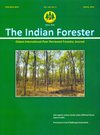Initial Growth Performance of Melia composita Willd and Emblica officinalis Gaertn Based Agri-Silvi-Medicinal Agroforestry in Degraded Lands
DOI:
https://doi.org/10.36808/if/2016/v142i3/90965Keywords:
Melia composita, Emblica officinalis Medicinal Plants, Sustainability, Integrated, Agri-Silvi-Medicinal Agroforestry.Abstract
An experiment was conducted on agri-silvi-medicinal agroforestry in degraded lands at Naukragrant, Haridwar (Uttarakhand) and Handesra, Mohali (Punjab) during 2011-13. Six months aged seedlings of Melia composita and Emblica officinalis were planted at 6 x 4 m spacing and medicinal plants namely Rauvolfia serpentina and Withania somnifera were cultivated at 60 x 60 cm spacing as an intercrop along with seasonal agriculture crops like masoor and groundnut.
Soil pH organic carbon and available nitrogen, phosphorus, potassium and height and collar diameter of Melia composita and Emblica officinalis were observed. Initially, soil was slightly alkaline with pH values (8.20 and 8.18) at sites Naukragrant and Handesra respectively. The average soil pH was found neutral (7.18) at site Naukragrant and slightly alkaline (8.01) value showed at site Handesra after one year of plantation. The organic carbon, available nutrients (nitrogen and phosphorus) values indicates increases at both sites and highest values found at site Naukragrant as compared to site Handesra.
The growth parameter both of height and collar diameter of Melia composita and Emblica officinalis showed increase along with cultivation of agriculture crops and medicinal plants at both sites. The maximum increase in height (47.33 cm) and collar diameter (3.89 cm) of Melia composita with agriculture crops was observed at site Naukragrant in comparison of height and collar diameter in control plot. Similarly the maximum increase in height (29.67 cm) of Emblica officinalis with Sarpgandha at site Handesra and collar diameter (1.78 cm) of Emblica officinalis with Ashwagandha was observed at site Naukragrant with regard to height and collar diameter in control plot. The minimum increase in height (1.11 cm) of Emblica officinalis with agriculture crops at site Naukragrant and (1.89 cm) of Melia composita with agriculture crops at site Handesra with regard to control height was also observed. It may be due to closer competition in nutrients uptake by agricultural crops in comparison to control.
References
Bhadauria S. (2005). Chemistry and cultivation technology of Emblica officinalis- An alternative land use for alternative land use for alkali wasteland. In: Recent Advances in Medicinal Plant Research: Vision 21st Century, (S.K. Prabhuji, G.P. Rao and S.K. Patil eds.) Satish Publication House, New Delhi, Pp. 159-170.
Dutt V. and Thakur P.S. (2004). Bio-economics of cropping systems combining medicinal and aromatic herbs with commercial timber tree species. Ind. J. Agrofor., 6: 1-7
Gill A.S and Gupta S.K. (2007). Evaluation of trees for biomass production under agroforestry system in rainfed semi-arid subtropics. Indian J. Trop. Biodiv., 15(2): 155-159.
Giller K. E. (2001). Nitrogen fixation in tropical cropping systems. 2nd edition, Cabi Series, CABI Publishing series, Wallingford, U.K, Pp. 222- 250.
Jackson M.L. (1973). Soil Chemical Analysis. Prentice Hall of India Ltd., New Delhi.
Piper C.S. (1950). Soil and Plant Analysis. Adelaide University Press, Adelaide, Australia.
Puri S. and Nair P.K.R. (2004). Agroforestry research for development in India: 25 years of experience of a national programme. Agroforestry Systems, 61:437-452.
Ram Newaj, Shukla S.K. and Yadav R.S. (1998-99). Varietal evaluation of aonla (Emblica officinalis) in agrisilvihorticultural system under rainfed conditions on marginal lands. Annual Report, NRCAF, Jhansi, pp.44-46.
Singh G., Singh H., Dagar T.C., Singh N.T. and Sharma V.P. (1977). Evaluation of agriculture, forestry and agroforestry practices in terms of productivity, sustainability and economics in moderately alkali soil. Agroforestry Systems, 37: 279-295.
Singh A.K., Saggar S. and Banerjee S.K. (2001). Fertilizer response to growth of Dalbergia sissoo. Roxb. in a highly degraded land. Indian Journal of Tropical Biodiversity, 9: 42-49.
Downloads
Downloads
Published
How to Cite
Issue
Section
License
Unless otherwise stated, copyright or similar rights in all materials presented on the site, including graphical images, are owned by Indian Forester.





